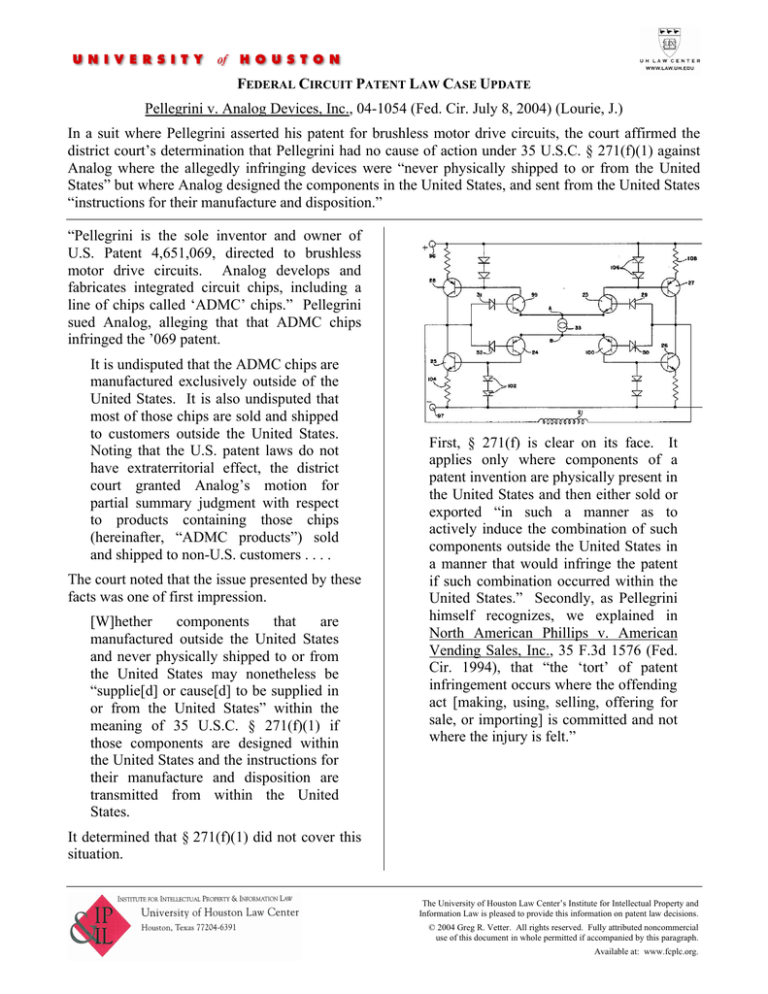
FEDERAL CIRCUIT PATENT LAW CASE UPDATE
Pellegrini v. Analog Devices, Inc., 04-1054 (Fed. Cir. July 8, 2004) (Lourie, J.)
In a suit where Pellegrini asserted his patent for brushless motor drive circuits, the court affirmed the
district court’s determination that Pellegrini had no cause of action under 35 U.S.C. § 271(f)(1) against
Analog where the allegedly infringing devices were “never physically shipped to or from the United
States” but where Analog designed the components in the United States, and sent from the United States
“instructions for their manufacture and disposition.”
“Pellegrini is the sole inventor and owner of
U.S. Patent 4,651,069, directed to brushless
motor drive circuits. Analog develops and
fabricates integrated circuit chips, including a
line of chips called ‘ADMC’ chips.” Pellegrini
sued Analog, alleging that that ADMC chips
infringed the ’069 patent.
It is undisputed that the ADMC chips are
manufactured exclusively outside of the
United States. It is also undisputed that
most of those chips are sold and shipped
to customers outside the United States.
Noting that the U.S. patent laws do not
have extraterritorial effect, the district
court granted Analog’s motion for
partial summary judgment with respect
to products containing those chips
(hereinafter, “ADMC products”) sold
and shipped to non-U.S. customers . . . .
The court noted that the issue presented by these
facts was one of first impression.
[W]hether
components
that
are
manufactured outside the United States
and never physically shipped to or from
the United States may nonetheless be
“supplie[d] or cause[d] to be supplied in
or from the United States” within the
meaning of 35 U.S.C. § 271(f)(1) if
those components are designed within
the United States and the instructions for
their manufacture and disposition are
transmitted from within the United
States.
First, § 271(f) is clear on its face. It
applies only where components of a
patent invention are physically present in
the United States and then either sold or
exported “in such a manner as to
actively induce the combination of such
components outside the United States in
a manner that would infringe the patent
if such combination occurred within the
United States.” Secondly, as Pellegrini
himself recognizes, we explained in
North American Phillips v. American
Vending Sales, Inc., 35 F.3d 1576 (Fed.
Cir. 1994), that “the ‘tort’ of patent
infringement occurs where the offending
act [making, using, selling, offering for
sale, or importing] is committed and not
where the injury is felt.”
It determined that § 271(f)(1) did not cover this
situation.
The University of Houston Law Center’s Institute for Intellectual Property and
Information Law is pleased to provide this information on patent law decisions.
© 2004 Greg R. Vetter. All rights reserved. Fully attributed noncommercial
use of this document in whole permitted if accompanied by this paragraph.
Available at: www.fcplc.org.


